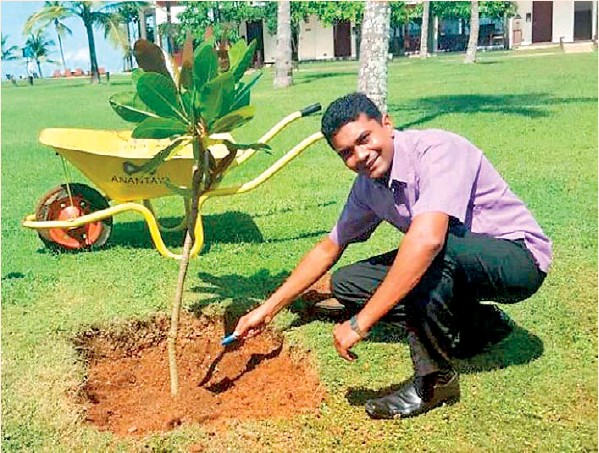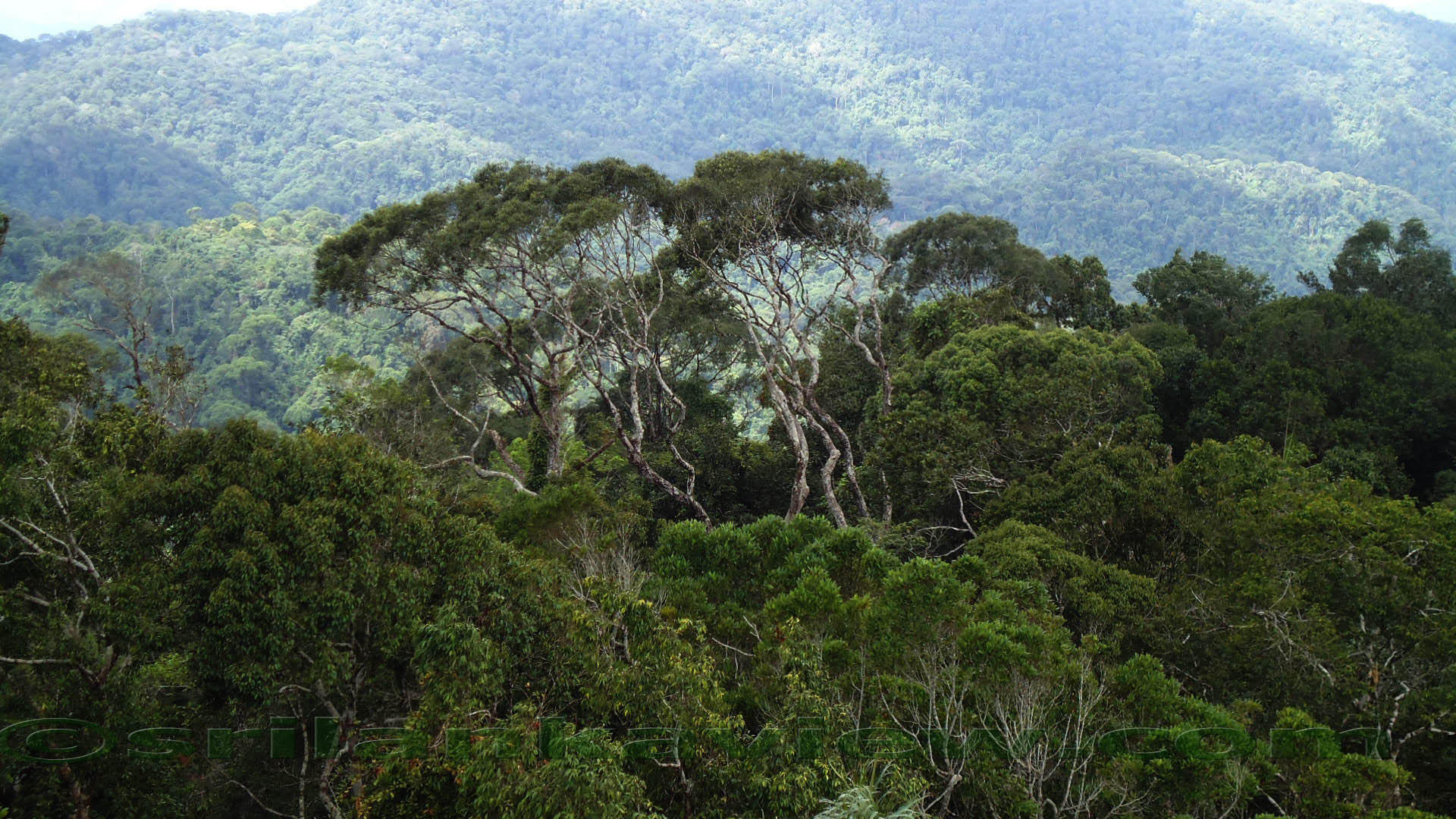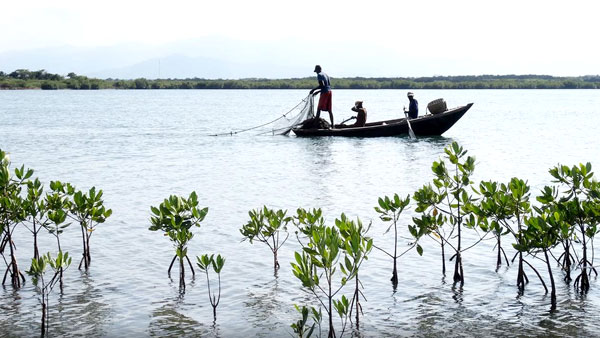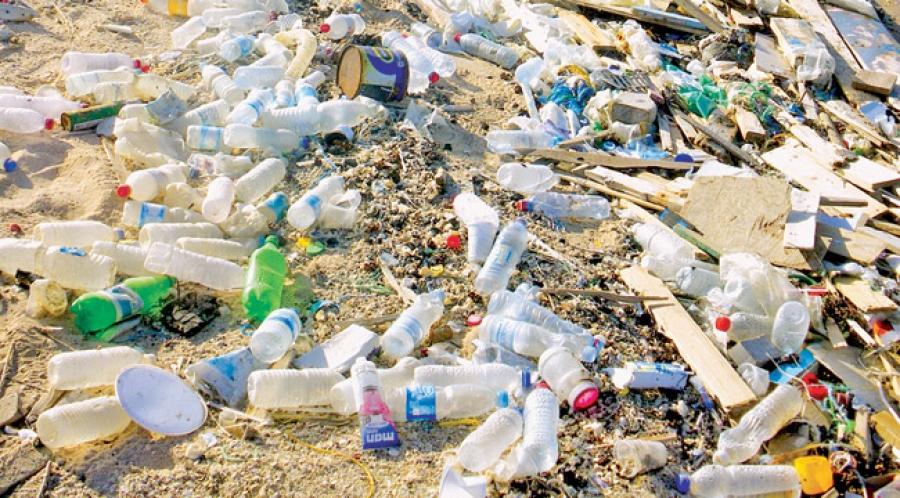
Earth could be Home to 1 Trillion Species

(Rendering of bacterium. The Earth Microbiome Project – a global multidisciplinary project to identify microscope organisms )
The Earth is teeming with life, and apparently humans have only identified one-thousandth of 1 percent of the various species that call the planet home. A new study out of Indiana University, published in the Proceedings of the National Academy of Sciences, reveals that Earth could contain nearly 1 trillion species.
“Estimating the number of species on Earth is among the great challenges in biology,” study co-author Jay T. Lennon, associate professor in the Indiana University Bloomington College of Arts and Sciences, said in a press release. “Our study combines the largest available datasets with ecological models and new ecological rules for how biodiversity relates to abundance. This gave us a new and rigorous estimate for the number of microbial species on Earth.”
The estimate of 1 trillion species was derived from large datasets of recorded plant, microbial, and animal life, from a combination of academic, governmental, and citizen science reports representing more than 5.6 million microscopic and non-microscopic species that exist in 35,000 locations around the world. The researchers call this the largest-ever compilation of such data. All the oceans and continents are represented except for Antarctica.
A big challenge in determining the true number of species on Earth is the fact that it is next to impossible to record all of the forms of microbial life on the planet. “Until recently, we’ve lacked the tools to truly estimate the number of microbial species in the natural environment,” Lennon said. “The advent of new genetic sequencing technology provides an unprecedentedly large pool of new information.”
Simon Malcomber, director of the National Science Foundation’s (NSF) Dimensions of Biodiversity program, stressed that while the study is significant, it highlights just how much life on Earth “still remains to be discovered and described.”
The NSF funded the Indiana University team’s work through a project that aims to “fill major gaps in humanity’s knowledge about the planet’s biodiversity” by 2020, according to the press release. The U.S. Army Research Office also supported the study.
What really differentiates this work is that most studies of life on Earth seemingly ignore microorganisms. Previous efforts to estimate the total number of species on Earth used outdated techniques “or questionable extrapolations,” Lennon said
“Older estimates were based on efforts that dramatically under-sampled the diversity of microorganisms,” Lennon said. But now, advanced genetic sequencing technology can be brought to bear. “Before high-throughput sequencing, scientists would characterize diversity based on 100 individuals, when we know that a gram of soil contains up to a billion organisms, and the total number on Earth is over 20 orders of magnitude greater.”
The study used data from the National Institutes of Health’s Human Microbiome Project, the Tara Oceans Expedition, and the Earth Microbiome Project, among others. The research team pulled together 20,376 surveys of bacteria, archaea and microscopic fungi along with 14,862 sampling efforts on trees, mammals, and birds.
“We suspected that aspects of biodiversity, like the number of species on Earth, would scale with the abundance of individual organisms,” said Kenneth J. Locey, study co-author and a postdoctoral fellow at Indiana University. “After analyzing a massive amount of data, we observed simple but powerful trends in how biodiversity changes across scales of abundance. One of these trends is among the most expansive patterns in biology, holding across all magnitudes of abundance in nature.”
Of course, it is still an overwhelming — if not impossible — task to accurately identify every microbial species on the planet. By comparison, the Earth Microbiome Project has been able to only record 10 million species, so far.
“Of those cataloged species, only about 10,000 have ever been grown in a lab, and fewer than 100,000 have classified sequences,” Lennon stressed. “Our results show that this leaves 100,000 times more microorganisms awaiting discovery — and 100 million to be fully explored. Microbial biodiversity, it appears, is greater than ever imagined.”
(Source 04-05-2016 CBS News http://www.cbsnews.com/news/earth-could-be-home-to-1-trillion-species/)

Sri Lanka gets Korean support to tackle worsening marine pollution
South Korea is to help Sri Lanka tackle its worsening marine pollution, especially from plastic waste and industrial effluent, which can affect fisheries and tourism, a government spokesman said.
A study on the sources and impact of marine debris in Sri Lanka is to be done by surveying marine debris on the beach and underwater.
Health Minister Rajitha Senaratne said the Cabinet of Ministers has approved a project proposal under which Expo 2012 YEOSU Korea Foundation, which works to support sustainable development, will help with the study. It will be done through an agreement with Sri Jayawardenepura University and the Marine Environmental Protection Authority to ensure sustainable fisheries and tourism, he told a news conference.
The project will help to establish a policy to cope with marine debris, help Sri Lankan scientists to use equipment to survey marine debris and develop educational material to educate the public. Recent studies show the amount of plastic waste that gets into the sea from Sri Lanka each year is 240,000 – 640,000 tonnes, according to the proposal made by President Maithripala Sirisena, in his capacity as the Minister of Mahaweli Development and Environment.
Marine debris, which mostly comes from land-based activity, can travel the whole world with ocean currents and wind. Other studies have shown alarming levels of heavy metal accumulation in edible species in coastal water bodies like the Negombo lagoon and Bolgoda Lake believed to be originating from nearby industrial zones like Katunayake and Ekala and municipal sources. (April 28 2016 ECONOMYNEXT -Colombo)
World Migratory Bird Day
World Migratory Bird Day (WMBD) was initiated in 2006 and is an annual awareness-raising campaign highlighting the need for the conservation of migratory birds and their habitats. Each year, on the second weekend in May.
Why migratory birds?
Avian migration is a natural miracle. Migratory birds fly hundreds and thousands of kilometres to find the best ecological conditions and habitats for feeding, breeding and raising their young. When conditions at breeding sites become unfavourable, it is time to fly to regions where conditions are better.
There are many different migration patterns. The majority of birds migrate from northern breeding areas to southern wintering grounds. However, some birds breed in southern parts of Africa and migrate to northern wintering grounds, or horizontally, to enjoy the milder coastal climates in winter. Other birds reside on lowlands during the winter months and move up a mountain for the summer.
Migratory birds have the perfect morphology and physiology to fly fast and across long distances. Often, their journey is an exhausting one, during which they go to their limits. The Red Knot has one of the longest total migration routes of any bird, travelling up to 16,000 kilometres twice a year. It breeds in Siberia and overwinters on the west coast of Africa, some even going down to the tip of South Africa.
It is truly amazing how migratory birds can navigate with pin-point accuracy. Exactly how migrating birds find their flyways is not fully understood. It has been shown that they are able to orientate by the sun during the day, by the stars at night, and by the geomagnetic field at any time. Some species can even detect polarized light, which many migrating birds may use for navigation at night.
Why Migratory Birds Need Protection
Migration is a perilous journey and involves a wide range of threats, often caused by human activities. And as diverse as people and their habits in different countries are, so are threats the birds face. As migratory birds depend on a range of sites along their distribution area, the loss of wintering and stopover sites could have a dramatic impact on the birds’ chances of survival.
Flying long distances involves crossing many borders between countries with differing environmental politics, legislation and conservation measures. It is evident that international cooperation among governments, NGOs and other stakeholders is required along the entire flyway of a species in order to share knowledge and to coordinate conservation efforts. The legal framework and coordinating instruments necessary for such cooperation is provided by multilateral environmental agreements such as CMS and AEWA.
World Migratory Bird Day has a global outreach and is an effective tool to help raise global awareness of the threats faced by migratory birds, their ecological importance, and the need for international cooperation to conserve them.
The 2016 World Migratory Bird Day Theme
…. and when the skies fall silent? Stop the illegal killing, taking and trade!
So that future generations also benefit from natural resources, governments have passed laws – both domestic and international – to ensure sustainability, protecting wild animals including migratory birds by restricting or prohibiting their exploitation. The protection of migratory birds has been coordinated at the international level since the beginning of the twentieth century. Migratory birds were once synonymous with abundance, and seen as a gift coming from the sky. Historically, people have hunted wildlife for a variety of reasons – food and sport – and in the past, such activities were conducted at a scale that was sustainable. In many cases, however, this is no longer true.
Nets along the north coast of Africa kill millions of birds every year – and it is only one example amongst many. The methods used and the numbers taken have changed beyond measure, and the survival of the targeted species which have to face many other pressures such as loss or deterioration of habitats is in doubt. In many countries, robust legislation exists and mechanisms are in place to enforce it; in others, the rules are not followed and the authorities lack the resources or the will to implement them properly on the ground. If once common migratory birds are to be prevented from disappearing, such as the Linnet that has lost 50% of its population since 1980, or the farmland birds with a loss of 300 million individuals in Europe over the same period, the public has to be made aware of the urgency of the threat posed by illegal hunting, taking and trade. Attitudes must change and we can no longer afford to turn a blind eye to those who flout the law and endanger our shared natural heritage.
There is a wide range of reasons for the illegal killing, taking and trade of birds – subsistence uses, recreational activities, organized crime, traditional practice and so on. They vary from one country to another, from one region of the world to another, according to what has been defined as legal or illegal – if at all. Indeed in some countries there is clearly no regulation, while in others regulations do exist but enforcement needs to be improved. Illegal activities not only affect birds’ populations, but they also harm society in general, our very existence and our natural resources. Conservation, agriculture and the tourism sector all suffer from their negative impacts. Legal hunting is affected by these illegal activities as well: despite the role that hunters play in ensuring the sustainability of livelihoods and habitats, they see their reputation jeopardized by illegal killing. While at the same time, elsewhere in the world, these illegal activities are widely socially accepted and therefore persist. Both at the national and the local level, law enforcement is the key driver to help protecting migratory birds, not only in one place but along their entire flyway.
Cooperation and awareness-raising have to be strengthened in order to fight illegal killing. The Task Force set up by the CMS Secretariat is a first concrete answer to the issue in the Mediterranean region. Further actions are needed – and this shared issue should involve and bring together international organizations, governments and civil society. Indeed decisions taken by the international community or by governments will not meet any success if they are not respected or implemented on the ground. That is where civil society has a role to play, at the local level. Let us work together to protect migratory birds from illegal killing, taking and trade!
(Source 03-05-2015 World Migratory Birdday http://www.worldmigratorybirdday.org/)

Depleted Oxygen in the Ocean Caused by Climate Change Threatens Marine Life

(Photo : Joe Raedle/Getty Images)
The National Center for Atmospheric Research (NCAR) said that by 2030, the ocean might have an alarming level of depleted oxygen which threatens the marine life and human resources as well.
Because of climate change, even the Great Barrier Reef is currently suffering from coral bleaching. But that’s not the only problem caused by climate change. The extreme weather conditions and warmer water also results to the depletion of the oxygen level in the waters.
According to the report by NCAR, “a warming climate can be expected to gradually sap the ocean of oxygen, leaving fish, crabs, squid, sea stars, and other marine life struggling to breathe”. Matthew Long, a scientist at NCAR added “Loss of oxygen in the ocean is one of the serious side effects of a warming atmosphere, and a major threat to marine life.”
Gizmodo also reported the depletion of oxygen level in the ocean. They said that it can be explained by “basic thermodynamics, cold water can hold more dissolved gases than warm water. As our ever-warming atmosphere heats the surface of the ocean, the oxygen content starts to fall. Also, as water warms, it expands and gets lighter. This makes it less likely to sink, which in turn reduces the transport of oxygen from the atmosphere into the deep ocean.”
The problem with depleted oxygen supply is that it greatly threatens marine life. The fishes and other marine animals survive the waters because of the presence of oxygen. Major changes in the environment will affect their ability to thrive.
According to the study published by the Global Biochemical Cycles, the depletion of oxygen in the ocean is already happening, but the most crucial and detectable influence to marine life can be felt by 2030.
They study also states that the oxygen level is important in regulating metabolic and bio-geochemical processes of marine life and the ocean. If the water turns warmer, it will be more difficult for the oxygen to travel deeper, which threatens marine life in deeper sea levels.
Currently, the researchers claim that the deoxygenation in the oceans is already felt in some areas in the world. The study said it is already detected in the southern Indian Ocean and parts of the eastern tropical Pacific and the Atlantic.
The depleted oxygen level in the ocean which threatens the marine life should be reason enough for mankind to try and curb climate change. If it does transpire in 2030, it won’t just affect marine life but the natural cycle in life. Imagine how a dead ocean ecosystem affects the livelihood and resources of men.
(Source :01/05/2016 :Nature World News http://www.natureworldnews.com/articles/21378/20160430/depleted-oxygen-in-the-ocean-caused-by-climate-change-threatens-marine-life.htm)
Depleted Oxygen in the Ocean Caused by Climate Change Threatens Marine Life

(Photo : Joe Raedle/Getty Images)
The National Center for Atmospheric Research (NCAR) said that by 2030, the ocean might have an alarming level of depleted oxygen which threatens the marine life and human resources as well.
Because of climate change, even the Great Barrier Reef is currently suffering from coral bleaching. But that’s not the only problem caused by climate change. The extreme weather conditions and warmer water also results to the depletion of the oxygen level in the waters.
According to the report by NCAR, “a warming climate can be expected to gradually sap the ocean of oxygen, leaving fish, crabs, squid, sea stars, and other marine life struggling to breathe”. Matthew Long, a scientist at NCAR added “Loss of oxygen in the ocean is one of the serious side effects of a warming atmosphere, and a major threat to marine life.”
Gizmodo also reported the depletion of oxygen level in the ocean. They said that it can be explained by “basic thermodynamics, cold water can hold more dissolved gases than warm water. As our ever-warming atmosphere heats the surface of the ocean, the oxygen content starts to fall. Also, as water warms, it expands and gets lighter. This makes it less likely to sink, which in turn reduces the transport of oxygen from the atmosphere into the deep ocean.”
The problem with depleted oxygen supply is that it greatly threatens marine life. The fishes and other marine animals survive the waters because of the presence of oxygen. Major changes in the environment will affect their ability to thrive.
According to the study published by the Global Biochemical Cycles, the depletion of oxygen in the ocean is already happening, but the most crucial and detectable influence to marine life can be felt by 2030.
They study also states that the oxygen level is important in regulating metabolic and bio-geochemical processes of marine life and the ocean. If the water turns warmer, it will be more difficult for the oxygen to travel deeper, which threatens marine life in deeper sea levels.
Currently, the researchers claim that the deoxygenation in the oceans is already felt in some areas in the world. The study said it is already detected in the southern Indian Ocean and parts of the eastern tropical Pacific and the Atlantic.
The depleted oxygen level in the ocean which threatens the marine life should be reason enough for mankind to try and curb climate change. If it does transpire in 2030, it won’t just affect marine life but the natural cycle in life. Imagine how a dead ocean ecosystem affects the livelihood and resources of men.
(Source :01/05/2016 :Nature World News http://www.natureworldnews.com/articles/21378/20160430/depleted-oxygen-in-the-ocean-caused-by-climate-change-threatens-marine-life.htm)

How Climate Change Affects Ocean’s Oxygen Level
The continues global warming due to climate change has been known to take its toll to Arctic, melting ice caps at an increased rate, but a new study suggests that the warming climate may be sapping considerably amounts of oxygen from the ocean.

(Photo : Lam Yik Fei/Getty Images)
According to the study published in the journalProceedings of the Royal Society B, scientist have long known that the warming climate can sap oxygen from the ocean, but they have discovered that a considerable amount of oxygen reduction in some oceans are already discernable, and by 2030 and 204 the loss of oxygen level across large oceans around the world will become more apparent.
With the reduction of the ocean’s oxygen level, marine species such as fishes, crabs and squids will have more difficulty of breathing, which can result to the sudden death and development of larger dead zones where no marine life can live.
“Loss of oxygen in the ocean is one of the serious side effects of a warming atmosphere, and a major threat to marine life,” said NCAR scientist Matthew Long, lead author of the study, said in a statement.
If the atmosphere becomes warmer than usual, oceans ability to draw oxygen from the atmosphere will be inhibited leaving it dependent to its other source of oxygen-the photosynthesizing phytoplankton.
In order to have a better grasp in the natural heating and cooling cycles and complex systems of currents and upwelling of oceans, researchers utilized the National Center for Atmospheric Research’s (NCAR) Community Earth System Model. They ran the model multiples times for the years 1920 through 2100. The researchers accounted global warming by making slight manipulations in air temperature.
After running the model, researchers identified that the reduction of oxygen in the ocean that can be attributed to global warming is apparent in 2030.
“Since oxygen concentrations in the ocean naturally vary depending on variations in winds and temperature at the surface, it’s been challenging to attribute any deoxygenation to climate change. This new study tells us when we can expect the impact from climate change to overwhelm the natural variability,” Long concluded.
(Source : 29/04/2016 Nature World News http://www.natureworldnews.com/articles/21285/20160428/climate-change-affects-ocean-s-oxygen-level.htm)

Anantaya launches green campaign
The Anantaya Resort chain of Laugfs Leisure Limited has yet again embarked on another green i nitiative as part of its sustainability efforts.
Renowned for its ‘eco luxury’ concept, Anantaya recently launched a tree planting drive at its Chilaw resort, as part of a broader campaign to strengthen its commitment towards the environment and community within which it operates. The initial tree planting drive took place along the road leading up to the Chilaw resort premises, adding a fresh touch of greenery to the surroundings. This initiative will be also rolled out at the newly built Anantaya Resort & Spa in Pasikudah, which is expected to be launched soon.
Anantaya will also be one of the first hotels to initiate eco tours in Sri Lanka, deploying eco-friendly vehicles consisting of electric and hybrid vehicles for excursions. Its resort in Chilaw will soon be geared to offer its guests with visits to the Anawilundawa Bird Sanctuary and Wilpattu National Park, both located in close proximity to the resort, in state-of-the-art electric sport utility vehicles (SUVS). Its environmentally friendly vehicle fleet will also be utilized for airport pickups and drops, as well as daily travel needs of its guests.
“Today environment concerns are mounting beyond imagination, with many adverse effects of environmental pollution felt all over the world. Present-day travellers are very much concerned about their environmental footprint through various product and service associations,” remarked Laugfs Leisure CEO Roshan R. Perera.
“Laugfs’ commitment to a sustainable future is ingrained in not just our approach to business but in also how we do business. The Anantaya Resort chain has also been following this philosophy from day one. Our ‘eco luxury’ concept at Anantaya Chilaw is a good example of this,” he further added.
The hotel architecture and landscape areas of Anantaya Resort & Spa i n Chilaw have been designed t o preserve t he surrounding natural environment, striking a fine balance between eco-friendliness and luxury. Many energy saving and conservation measures have been built into the design of the resort, with careful consideration given to functional details such as the type of air conditioning used, installation of solar panels wherever possible, use of natural light for public spaces and recycling of treated sewerage water for irrigation. This has helped Anantaya to achieve substantial savings in energy and water management, while preserving the natural beauty of the area.
The Anantaya luxury resort chain is owned and managed by Laugfs Leisure Limited, a subsidiary of Laugfs Gas PLC.
Source : 29-04-2016 Daily Mirror (Sri Lanka)

World Bank gives US$45mn to protect Sri Lanka’s natural habitat
The World Bank has approved a 45 million US dollar loan to help protect Sri Lanka’s natural habitats and resources from degradation and exploitation.
The money will also help improve the lives and livelihoods of neighboring communities, who suffer the most from natural resource loss and degradation, a statement said.
“Natural ecosystems in Sri Lanka provide clean water, food, medicine, carbon storage, recreation and habitats for local communities, wildlife and fisheries, and prevent floods and erosion,” said Francoise Clottes, World Bank Country Director for Sri Lanka and the Maldives.
“If well managed, these areas will benefit the national economy, spur Sri Lanka’s nature-based tourism potential, and help address local challenges brought on by poverty, decreased productivity and degradation of land and water, human-wildlife conflicts, and climate change.”
The Eco-systems Conservation and Management Project (ESCAMP) will benefit 15,000 residents; 30 percent among them women, with most belonging to marginalized groups, the bank said.
It will protect and foster the sustainable use of natural resources help create jobs and livelihoods.
Through the Department of Wildlife Conservations and Forest Department, the project will manage protected natural areas through improved landscape management, raise awareness and improve coordination on natural resource management among local authorities, and increase the quality of nature-based tourism.
“The project will improve the management and stewardship of protected areas and other biologically important locations throughout Sri Lanka,” said Darshani De Silva, Environment Specialist and Project Task Team. “It will help establish networks to protect ecosystems, maintain the population of endemic species, while promoting environmentally sound infrastructure development and visitor services to raise the quality and revenue potential of green tourism.”
The project also aligns with the government’s policies to expand forest cover in line with Sri Lanka’s conservation strategy ‘Punarudaya’. The project, to be done by the Ministry of Mahaweli Development and Environment and Ministry of Sustainable Development and Wildlife, will develop human-elephant co-existence mechanism and protect watersheds to boost agricultural productivity, the World Bank said.
“Over time, the project will reinforce the emerging strategy on Reducing Emissions from Deforestation and Forest Degradation as well as policies to promote sustainable water, agriculture and energy practices, while supporting social inclusion and resilience to climate and disaster risks.”
The loan is provided by the International Development Association – the World Bank’s concessionary lending arm –with a maturity of 25 years, including a 5 year grace period.
(Source : 28-04-2016 Economy Next. http://www.economynext.com/World_Bank_gives_US$45mn_to_protect_Sri_Lanka%E2%80%99s_natural_habitats-3-4832.html)

Agree to be Green
As many as 195 States were parties to the discussions in Paris on the COP 21 Agreement which was accepted in general by consensus. The Agreement will be deposited at the UN in New York and opened for one year for signature on April 22, 2016–Mother Earth Day. The Agreement will enter into force after 55 countries that account for at least 55% of global emissions have deposited their instruments of ratification
It was recently reported that Cabinet approval had been given for Science, Technology and Research Minister Susil Premajayantha to sign on behalf of the Sri Lankan government the Paris Agreement adopted by the Conference of The Parties (COP 21) to The United Nations Framework Convention on Climate Change UNFCCC) held in September 2015. It is understood that Cabinet approval was granted not for the mere signature of the treaty (which is not sufficient for the treaty to be applicable to Sri Lanka) but for the ratification of this Agreement by which Sri Lanka will be bound by the principles enunciated in the Agreement. Minister Premajayantha is to participate in the high level signature ceremony on April 22 at The Headquarters of the United Nations in New York.
As many as 195 States were parties to the discussions in Paris on the COP 21 Agreement which was accepted in general by consensus. The Agreement will be deposited at the UN in New York and opened for one year for signature on April 22, 2016–Mother Earth Day.
The Agreement will enter into force after 55 countries that account for at least 55% of global emissions have deposited their instruments of ratification. The overall aim of the Agreement is to maintain a global temperature rise in the 21st century to well below 2 degrees Celsius and to strive to limit the temperature increase even further to 1.5 degrees Celsius above pre-industrial levels, the lower level recognized as a buffer against worst case scenario impacts of climate change. Another important goal of the Agreement is to strengthen the capacity of States to effectively address and mitigate the impacts of climate change.
Article 2 of the Agreement stipulates that the Agreement aims to strengthen the global response to the threat of climate change, in the context of sustainable development and efforts to eradicate poverty, including by: holding the increase in the global average temperature to well below 2 °C above pre-industrial levels and to pursue efforts to limit the temperature increase to 1.5 °C above pre-industrial levels, recognizing that this would significantly reduce the risks and impacts of climate change; increasing the ability to adapt to the adverse impacts of climate change and foster climate resilience and low greenhouse gas emissions development, in a manner that does not threaten food production; and making finance flows consistent with a pathway towards low greenhouse gas emissions and climate-resilient development.
Article 2.2. is explicit in stating that the Agreement will be implemented to reflect equity and the principle of common but differentiated responsibilities and respective capabilities, in the light of different national circumstances.
The Agreement also recognizes the need to put in place appropriate financial tools in order to achieve the aforementioned ambitious goals with a view to enabling developing states to face the challenges of mitigating climate change at their own pace and in accordance with their own national objectives.
There was considerable hope that the agreement would truly promote sustainable development.
UN Secretary General Ban Ki-moon said: “We have entered a new era of global cooperation on one of the most complex issues ever to confront humanity.
For the first time, every country in the world has pledged to curb emissions, strengthen resilience and join in common cause to take common climate action. This is a resounding success for multilateralism.”
National climate action plans
The critical areas covered by the COP 21 Agreement are: mitigation – reducing emissions fast enough to achieve the temperature goal; a transparency system and global stock-take – accounting for climate action; adaptation – strengthening ability of countries to deal with climate impacts; loss and damage – strengthening ability to recover from climate impacts; and support – including finance, for nations to build clean, resilient futures. The Agreement espouses a long term direction that would enable States to reach a peak in their emissions as soon as possible and continue to submit national climate action plans that detail their future objectives to address climate change.
A UNFCCC Secretariat statement claims that, in the spirit of the Agreement, 188 countries have undertaken to contribute climate action plans in accordance with the new agreement, which is calculated to dramatically slow the pace of global greenhouse gas emissions. The basic philosophy of the Agreement is that future national plans will be no less ambitious than existing ones, which means these 188 climate action plans provide a firm floor and foundation for higher ambition. It has also introduced nationally determined contributions (NDCs) – updated plans for reducing greenhouse gas emissions – once every five years, which will regularly and consistently improve their strategy towards achieving their overall goals in the long-term.
The Agreement also provides for action to be taken even before 2020 where States are required to continue to engage in a process on mitigation opportunities and will put added focus on adaptation opportunities. Furthermore, since reaching the ambitious target of 1.5% below industrial levels would mean keeping at least 75% of the current flow of fossil fuels on the ground, and using renewable energy instead, States will raise climate finance up to $ 100 billion by 2020 that would assist developing countries to develop such energy resources. States will, in this regard, work towards defining a clear roadmap on ratcheting up climate finance to USD 100 billion by 2020 while also before 2025 setting a new goal on the provision of finance from the USD 100 billion floor.
A roadmap in this regard will be developed by States. There will also be put in place a robust transparency and accounting system that would allow for special circumstances and respective capabilities of States to be recognized and taken as part of the equation. Support and cooperation are the main themes of this philosophy. The Agreement also strengthens international cooperation on climate-safe technologies and building capacity in the developing world to address climate change.
Developing countries
All States are required to submit adaptation communications, in which they may detail their adaptation priorities, support needs and plans. There is also provision for developing countries to receive increased support for adaptation actions, for which there will be an assessment of the adequacy of this support that will be given. As already mentioned, the Agreement has incorporated a robust transparency framework for both action and support. The framework will provide clarity on countries’ mitigation and adaptation actions, as well as the provision of support. At the same time, it recognizes that Least Developed Countries and Small Island Developing States have special circumstances.
According to the UNFCCC Secretariat, the agreement includes a global stock-take starting in 2023 to assess the collective progress towards the goals of the agreement. The stock-take will be done every five years and the agreement includes a compliance mechanism, overseen by a committee of experts that operates in a non-punitive way.
From a technical standpoint, COP 21 addressed a number of issues which go to say that under the Kyoto Protocol – which is an international treaty which extends the 1992 United Nations Framework Convention on Climate Change (UNFCCC) that commits State Parties to reduce greenhouse gases emissions, based on the premise that (a) global warming exists and (b) man-made CO2 emissions have caused it – there is now a clear and transparent accounting method for carry-over credits for the second commitment period, creating a clear set of rules; and the first round of international assessment and review process (IAR) that was launched in 2014 was successfully completed. A number of technical and implementation issues related to the existing arrangements on technology, adaptation, action for climate empowerment and capacity building were also successfully concluded.
The Stern Review of October 2006 titled The Economics of Climate Change stated that if no action is taken to reduce emissions, the concentration of greenhouse gases in the atmosphere could reach double its pre-industrial level as early as 2035, virtually committing us to a global average temperature rise of over 2 degrees centigrade. In this context, Sri Lanka’s ratification of the Paris Agreement shows an abiding sense of responsibility and awareness on the part of the State.
Source :26-04-2016 Dailly News http://www.dailynews.lk/?q=2016/04/26/features/79789

Sri Lanka among worst marine polluters
Sri Lanka has been ranked as one of the world’s worst marine polluters in a study conducted by international Business Times Magazine.
In the study where a country-by-country breakdown of plastics in oceans was recorded, Sri Lanka has been ranked as No 5, along with a number of other Asian countries.
China has been named as the number one offender, followed by Indonesia, the Philippines, Vietnam.
Sri Lanka has been ranked fifth in the chart with a waste generation rate of 5.1 kg per person per day. The study records that 0.299 kg of plastic is mismanaged by a person every day while the country generates 5,163,689 kilograms of plastic waste per day. The total waste generation is 74,297,687 kilograms per day.
Study highlights that plastic kills thousands of seabirds, sea turtles and marine mammals each year. Discarded bottles and packaging containers can also leak chemicals such as bisphenol A, which could be consumed by fish and eventually cause health problems for consumers.
Source – 26-04-2016 Dailly News http://epaper.dailynews.lk/art.asp?id=2016/04/26/pg19_13&pt=p&h=




